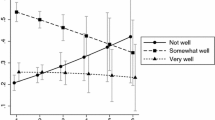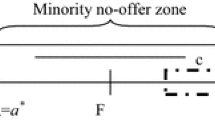Abstract
The current debate over models of self-selection in Congress — whether Congressmen by-and-large find themselves on committees which most closely correspond to their constituents' interests — has implications for theories of Congressional organization. Building on recent findings which question a categorical self-selection process, in this paper we present a theory of committee function based on loyalty to party leaders. As a rationale for leadership privilege, and to provide context for our argument, we first present a theoretical framework based on a modified model of cooperation. We then focus on certain specifics of our leadership theory; that rank-and-file members vote leadership interests in exchange for leader support in gaining choice committee assignments and aid in passing legislation. This leads to predictions about voting patterns across committees. Static tests of these relations are performed, as well as those incorporating changes in voting patterns with seniority.
Similar content being viewed by others
References
Akerlof, G. (1983). Loyalty filters.American Economic Review 73 (March): 54–63.
Axelrod, R. (1984).The evolution of cooperation. New York: Basic Books.
Crain, W.M. (1990). Committees as loyalty filters. In W.M. Crain and R.D. Tollison (Eds.),Predicting politics. Ann Arbor: University of Michigan Press.
Crain, W.M., Leavens, D.R. and Tollison, R.D. (1986). Final voting in legislatures.American Economic Review (September): 833–841.
Fiorina, M.P. (1977).Congress: Keystone of the Washington establishment. New Haven: Yale University Press.
Gart, J.J. and Zweifel, J.R. (1967). On the bias of various estimators of the Logit and its variance with applications to Quantal Bioassay.Biometrika 52 (1)(2): 181–187.
Gilligan, T.W. and Krehbiel, K. (1990). Organization of informative committees by a rational legislature.American Journal of Political Science 34 (2): 531–564.
Haeberle, S.H. (1978). The institutionalization of the subcommittee in the United States House of Representatives.Journal of Politics 40: 1054–1065.
Hall, R.L. and Grofman, B. (1990). The committee assignment process and the conditional nature of committee bias.American Political Science Review 84(4): 1149–1166.
Kalt, J.P. and Zupan, M.A. (1984). Capture and ideology in the economic theory of politics.American Economic Review (June): 279–300.
Kalt, J.P. and Zupan, M.A. (1990). The apparent ideological behavior of legislators: Testing for principal-agent slack in political institutions.Journal of Law and Economics (April): 103–132.
Krehbiel, K. (1990). Are congressional committees composed on preference outliers?American Political Science Review 84 (March): 149–163.
Leibowitz, A.A. and Tollison, R.D. (1980). A theory of legislative organization: Making the most of your majority.Quarterly Journal of Economics (March): 261–248.
Moe, T.M. (1987). An assessment of the positive theory of ‘congressional dominance’.Legislative Studies Quarterly (November): 475–520.
Munger, M.C. (1988). Allocation of desirable committee assignments: Extended queues versus committee expansion.American Journal of Political Science 32: 317–344.
Olson, M. (1965).The logic of collective action. Cambridge: Harvard University Press.
Peltzman, S. (1984). Constituent interest and congressional voting.Journal of Law and Economics (April): 181–210.
Price, D. (1989). The House of Representatives: A report from the field. In L. Dodd and B.I. Oppenheimer (Eds.),Congress reconsidered, 413–441. Washington, DC: CQ Press.
Rohde, D.W. (1991).Parties and leaders in the postreform House. Chicago: The University of Chicago Press.
Shepsle, K.A. (1978).The giant jigsaw puzzle: Democratic committee assignments in the modern House. Chicago: University of Chicago Press.
Shepsle, K.A. and Weingast, B.R (1987). The institutional foundations of committee power.American Political Science Review 81: 85–104.
Smith, S.S. (1988). An essay on sequence, position, goals, and committee power.Legislative Studies Quarterly 8(2): 151–176.
Weingast, B.R. (1979). A rational choice perspective on congressional norms.American Journal of Political Science 23(2): 245–262.
Weingast, B.R. and Marshall, W. (1988). The industrial organization of Congress.Journal of Political Economy 96: 132–163.
Weingast, B.R. and Moran, M.J. (1983). Bureaucratic discretion or congressional control? Regulatory policymaking by the Federal Trade Commission.Journal of Political Economy 91: 765–800.
Westefield, L.P. (1974). Majority party leadership and the committee system in the House of Representatives.American Political Science Review 68: 1593–1604.
Zellner, A. and Lee, T.H. (1965). Joint estimation of relationships involving discrete random variables.Econometrica 33(2): 382–394.
Author information
Authors and Affiliations
Additional information
We are grateful to Legi-Slate, most especially Ann Harris, for making the data available to us and to Tyler Cowen, Kevin Grier, Susanne Paine, Bob Reed, Joe Reid, Bob Tollison, and Bob Young for helpful comments. The authors assume responsibility for any errors.
Rights and permissions
About this article
Cite this article
Coker, D.C., Crain, W.M. Legislative committees as loyalty-generating institutions. Public Choice 81, 195–221 (1994). https://doi.org/10.1007/BF01053230
Accepted:
Issue Date:
DOI: https://doi.org/10.1007/BF01053230




